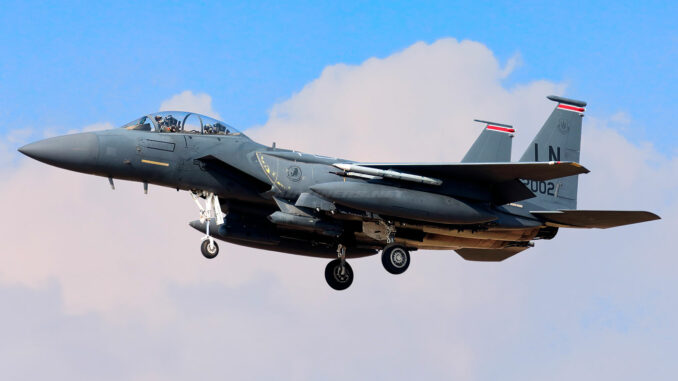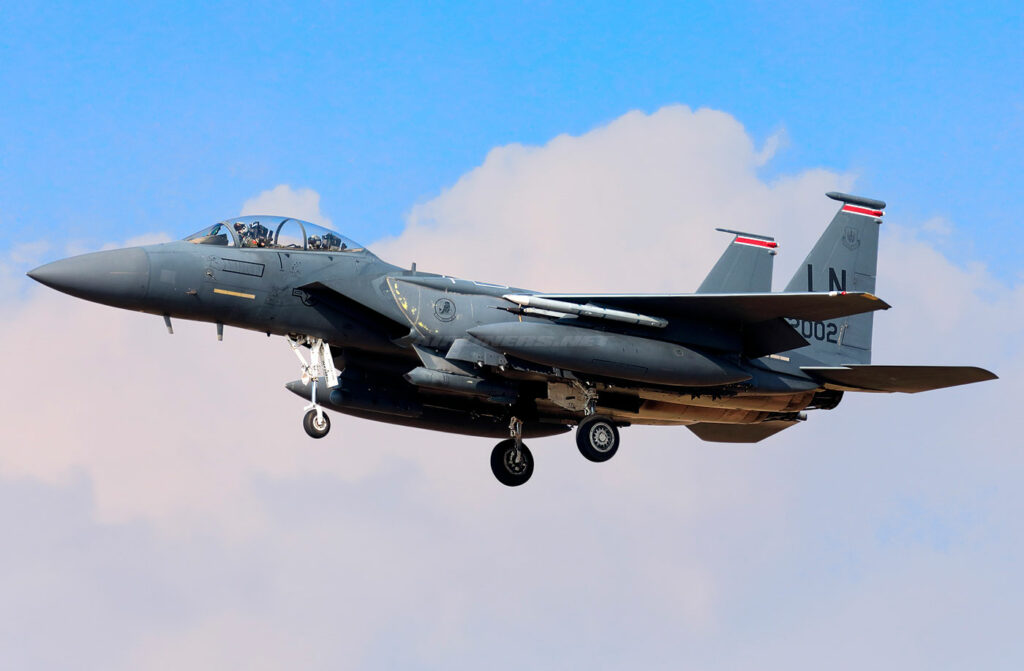
The F-15E modernizes with the EPAWSS system, improving its survivability in the face of modern threats. Analysis of capabilities and challenges.
The F-15E Strike Eagle, a US Air Force multi-role fighter, has received a crucial upgrade: the Eagle Passive/Active Warning Survivability System (EPAWSS). This state-of-the-art electronic warfare system enhances its ability to identify, locate and counter electronic threats in contested environments. Delivered to the 48th Fighter Wing based at RAF Lakenheath, it marks a turning point in the modernization of the US Air Force.
Background: modernization needed to meet today’s threats
Since the 1980s, the F-15E has served as a mainstay of US Air Force air operations. Originally designed with analog systems, it was becoming vulnerable to modern threats. Advances in air defense systems, such as the Russian S-500 capable of reaching targets over 480 km away, called for a major upgrade. The TEWS (Tactical Electronic Warfare System), dating from the 1970s, was obsolete.
The new EPAWSS is a response to these challenges. Developed by BAE Systems, it offers detection, jamming and electronic countermeasure capabilities adapted to modern threats, in particular radar-guided surface-to-air missiles.

EPAWSS technical capabilities
EPAWSS is designed to analyze the electromagnetic environment in real time. Its main functionalities include :
- Radar detection: identifies and locates ground and airborne radio frequency threats.
- Active jamming: neutralizes defense systems by disrupting their radar signals.
- Rapid upgrades: Its open architecture enables the integration of new software capabilities to counter emerging threats.
With EPAWSS, the F-15E can engage targets in electronically challenged environments while protecting its crew. For example, it can jam a radar guiding an S-400 missile, while collecting data for strategic reuse.
Delivery to the 48th Fighter Wing: an operational milestone
On January 15, 2025, the 48th Fighter Wing at RAF Lakenheath took delivery of its first EPAWSS-equipped F-15E. This delivery marks the start of a series of modernizations designed to extend the service life of the current fleet. The US Air Force currently owns 218 F-15Es, of which only 99 are scheduled to receive this upgrade as a priority. These aircraft are powered by Pratt & Whitney F100-PW-229 engines, offering 129 kN thrust per engine.
However, discussions are underway to increase this number. Congress has blocked the retirement of 68 aircraft before 2029, ensuring sufficient availability for future operations.
Strategic and technological consequences
The integration of EPAWSS not only improves the survivability of the F-15E, but also enhances its offensive capabilities. Benefits include :
- Lower maintenance costs: EPAWSS is more compact and digital, reducing maintenance costs.
- Interoperability: data collected can be shared with other platforms, optimizing joint operations.
- Adaptability: The ability to evolve in the face of unforeseen threats thanks to rapid software updates.
In competition with powers such as China and Russia, this upgrade strengthens the US Air Force’s preparedness for high-intensity conflicts.

Outlook for the future of the F-15 fleet
The future of the F-15E relies on a balance between modernization and renewal. While the EPAWSS is being integrated into the new F-15EXs, around 98 examples of this model are planned. These aircraft benefit from additional enhancements, such as advanced cockpit displays for improved threat visualization.
Despite a reduction in the originally planned quantities, the F-15EX and modernized F-15E will remain major assets in ensuring air superiority. With continued investment in systems such as EPAWSS, the fleet will be ready to face future challenges.
War Wings Daily is an independant magazine.